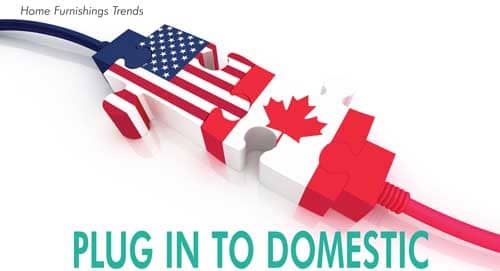
On January 21st 2012, the New York Times reported on an exchange of words between President Barack Obama and Steve Jobs, then the CEO of Apple. “‘What would it take to make iPhones in the United States... Why can’t that work come home?’” Mr. Obama asked. “Mr. Jobs’ reply was unambiguous,” noted the Times, “‘Those jobs aren’t coming back.’”
Jobs may have been correct. The iPhone may never again be manufactured here. The furniture industry, however, is showing signs of resurgence in the production and consumption of products that are made in the US and Canada. There are four general conditions that are making this possible:
- Lower availability and higher cost for goods sourced from Asia vs. domestically made furniture;
- An increase in domestic production, plus a broader choice of styles and price points;
- Rising consumer awareness and demand for domestically made home furnishings;
- Retailers are becoming more aware of the need to pay attention to buying, marketing, displaying and selling the category.
The editors at Furniture World interviewed retailers, manufacturers and marketing experts to provide perspective on this trend and, give readers suggestions to help them market the category.
The Furniture Supply Side Shift
In his book, “The Furniture Wars: How America Lost a Fifty Billion Dollar Industry”, Mike Dugan details the reasons why furniture manufacturing went overseas in the later part of the 20th century. Everyone in our industry is familiar with this story. He writes about how furniture importing accelerated as domestic furniture manufacturers transferred capital and manufacturing expertise to Asian factories. After the Sino-U.S. trade agreement in 1999 and China’s admittance into the World Trade Organization, this trend became unstoppable. By then, competitive pressures compelled industry players to take advantage of the cheap labor, business friendly environmental and work rules, and newer more efficient factory settings in overseas markets.
Recently though, the pendulum that once favored offshore production is swinging back toward a neutral position. “There’s a great back-story driving what’s happening in this industry,” observes Bruce Cochrane, President of the recent domestic case-goods start-up Lincolnton Furniture. “In China, goods are now being directed toward domestic consumption. Projections are that China will go from less than 5 per cent of global consumption to almost 25 per cent in the next eight years. US importers are, therefore, facing the prospect that China will be consuming much of what they can make, and be importing from much of Asia.”
According to Cochrane, ongoing structural changes in China’s economy, the impact of labor shortages, wage increase and higher shipping costs for Asian sourced goods, are causing something that few in our industry thought probable. “Retailers are seeing that it is tougher to get imported goods,” he says. “It may be just the tip of the iceberg, but there is definitely going to be a supply issue for furniture retailers.”
Santa Clarita, CA based retailer Norb Moniz, Jr., President of A Royal Suite Home Furnishings, agrees. “With prices of imported products on the rise, and the cost of getting them here increasing,” he notes, “we are seeing that it isn't as easy or as cheap as it used to be to get imported products. China's productivity and their cost of goods are rising rapidly.”
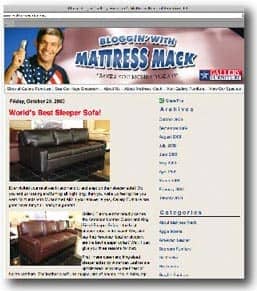 |
http://www.mattressmack.com Blog discusses products made in America as well as “cool” furniture finds in High Point, videos from customers about what they like and don’t like at Gallery Furniture, design information, store and community news. ‘Mack’ is pictured top left. |
Demand For American Made Furniture Is Rising
Furniture World asked Jim “Mattress Mack” McIngvale of Gallery Furniture to explain what’s driving an increase in consumer demand for domestic furniture.
“It’s a recession when your neighbor looses his job. It’s a depression when you lose yours.” He replied. “And everyone in this current environment has seen a neighbor be out of work. We’ve also noticed that this Made in America trend has picked up a lot of steam since ABC started talking about it on Good Morning America. I think that it is only going to become bigger, and more smart retailers will begin to tell the Made in America story because that’s what people want to hear.”
Diane Ray, President, Garden City Furniture, and NHFA Board Chairman also sees a positive trend. “Consumers are asking for domestically made products across the board,” she told Furniture World. “This young generation Y wants well-made products, and they don't want to wait 16 weeks to get a replacement part. They are used to getting instant gratification, and they are very picky about what they buy. These customers will buy one piece if that's all they can afford, and wait to get the other pieces as their financial situation permits. Our older customers are telling us, ‘oh it's so good to see made in America again.’ That's what I am hearing out on the floor.”
When asked about his younger customers, Chester Hine, President of New Mexico-based retailer Amish Connection, says that he sees the same customer buying behaviors as Diane Ray. Amish Connection sells only American made products. “Many of our customers are baby boomers,” he says, “but we are seeing more younger shoppers. Because we carry Amish made furniture, these younger customers have confidence that they can buy a bed and maybe one nightstand, then purchase the dresser later.” They don’t need to worry about the set being discontinued, so they don’t feel compelled to buy a complete, but more promotional set. “We can almost always,” Hine explained, “get matching pieces from our Amish craftsmen suppliers.
Even stuff that we sold years and years ago, and that we don't carry anymore, can be ordered. Our store has items from about 120 craftsmen on the sales floor including products like jams and jellies, plus smaller accessories. We shop both the Ohio Hardwood Furniture Market and the NIWA Indiana shows.”
Norb Moniz, Jr., has also noticed that demand for his domestically sourced products have increased, an observation that was a major motivation for his decision to move to a larger location and expand his selection of furniture made in America.
“Our community,” he noted, “is middle-class, and the middle class has been affected most by imported products. Before 2011, I don't think the middle class really realized the true impact of manufacturing plants being shut down across the US. Now they're starting to wake up. We get a substantial number of people who walk into our store after having shopped in the local big box store that carries a substantial amount, or all imported products. Many people from this community just don’t want to buy there anymore.”
Canadian retailers interviewed for this article emphasized that their customers are looking for locally made products, well constructed and competitively priced, but not necessarily Made in Canada. This outlook is quite possibly a reflection of the health of the Canadian economy that has seen much higher levels of job growth and lower unemployment over the last two years than its southern neighbor.
Paul Comrie, Senior Vice President for The Brick, one of Canada's largest volume retailers of household furniture, mattresses, appliances and home electronics says, “Our customers tell us that they want more Canadian made domestic goods and, depending on the region where a store is located, it can be more pronounced. But so far it’s only anecdotal information. We have no data to say there is an uptick, or that the consumer will pay a premium for domestic goods.”
Comrie says that in spite of this, The Brick’s “goal is to grow the rate of penetration of our domestic sales relative to our import sales, or at minimum at least maintain the current mix.”
Sue Toby, owner of Insideout Home Store, Victoria, British Columbia, emphasizes that her customers are more focused on the broader consumer trend towards seeking locally sourced products, that she considers to be made both in Canada and the USA.
“I believe there is a trend to buy locally made products,” she told us, “However, we usually say North American made, as we have so much to offer between the two countries.” She observes that, “people are very interested in local, but it is still about the dollar. Our customers are still shopping price, so even though they may want to buy local, if it’s made somewhere else cheaper, they will purchase cheaper.”
“I don’t think there is a trend per se for Canadian made furniture,” adds Steve Forberg of Toronto based Decorium, “but I have noticed a trend in consumers requiring better quality products. Whether it be from Canada, U.S. or Asia, they just want a product that will last.”
Paul Dekker, owner of Conway Furniture, Listowel, Ontario agrees that Canadians want value, but he has noticed increased awareness among his customers. “There is a trend,” he says, “and we are seeing people who realize we need manufacturing here in Canada and North America. They set out with that as part of their ideal, whether they end up buying Canadian or import depends on the salesperson and the value.
“Canadian consumers want value. The imported products, in many cases, are less expensive, especially on more unusual and elaborate looks. The challenge is to source more interesting domestic products that show good value, but that isn’t easy in a lot of categories. If you can show the value, the Canadian content is the clincher.”
 |
Google AdWords website at www.google.com/adwords2. It’s easy to quickly put up a pay per click campaign to take advantage of events and news items, but be careful. Poorly conceived campaigns can be non productive and expensive. |
Connect With Your Customers
Most of the people interviewed for this article, believe that furniture retailers can do a better job of connecting with potential customers who are interested in purchasing domestically made products.
We asked Katherine Andes who specializes in copywriting for SEO and web content development, to provide some expert guidance. She is also a contributor to Furniture World’s weekly e-newsmagazine.
TIP #1: Pick Appropriate Website Images
“If you decide to put patriotic logos such as flags on your website to show a commitment to domestically sourced furniture,” said Andes, “I recommend that these logos be placed on every single page. Look for logo that really stands out. Do a Google search for the phrases ‘Made in USA’, ‘Made in Canada’, etc., and then look at the top, or top left of the search results page. There will be a label that says ‘images’. Click on it and thousands of images will appear including lots of logos. Browse through them to see which ones clearly stand out, and strongly communicate where the products are made. Once you get an idea of what type of image will work for you, you can either hire a designer to create something similar from scratch, or click through and buy the rights to use an existing logo.”
Marcie Gabor is President, Made in USA Brand and a principal at marketing agency Conrad Phillips Vutech. The Made in USA Brand is an organization that helps American companies identify their products by providing them with the Made in USA Brand certification mark, a non-mandatory brand enhancer and identifier of goods made or grown in the United States. We asked her to also comment about choosing a logo to use for materials. “Many companies place small icons next to products to show that they are made with wind power or have recycled content, but they may not have an identifier for which products are made in the USA. There is a great opportunity to get this message across to customers, so even if they aren't looking specifically for products made in the USA, it now becomes top of mind. Studies have shown that new consumers, we call them conscientious consumers, who are thinking before they buy, are conditioned to look at labels. They already look for organic, or products made with wind energy or made locally. Polls have shown that there is an equal amount of interest in products made in the USA.”
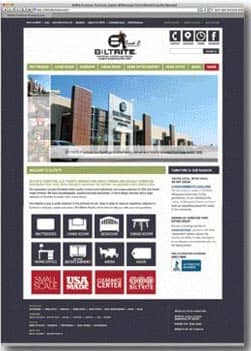 |
Biltrite Furniture in Milwaukee (http://biltritefurniture.com), has established an identity that includes many products that are made in America. The site says that, “Our specialties include affordable quality furniture and mattresses and a large selection of USA and Amish made furniture. The USA MADE logo appears on each page of their website. |
TIP #2: Add Alt & Title Tags To Your Website Images
“Once an image or images for your website have been selected,” continues Katherine Andes, “make sure that your developer fills in the alt tag, also called an alt attribute. Search engines use alt tags to identify images. So, if someone is searching online for products that are made in America, that logo will show up. Use a variety of alt tags. I searched for some key terms that furniture retailers should be looking at,” she told Furniture World. “For the month of January, 450,000 searches were made for the phrase ‘Made in America’. ‘Made in USA’ had 673,000, and ‘Made in the United States of America’ had 90,500 searches.
“I suggest that furniture retailers put the alt tag ‘Made in America’ on some pages, ‘Made in USA’ on others. ‘Made in the United States of America’ is not as important, but if you have a lot of pages, I would also recommend that you include that. For Canadian furniture retailers, adding alt tags for ‘Made in Canada’ is equally useful.”
Also make sure that your title tags include the title of the picture, and describe it accurately. Users will see this title when their mouse hovers over the picture.
TIP #3: Add Descriptive Text To Your Videos
Andes says that, “Videos are great and I highly recommend them, but always add text to summarize their content. Some users won’t be able to get your video to play, and others just won’t want to take the time to sit and listen. They would rather quickly scan the text.”
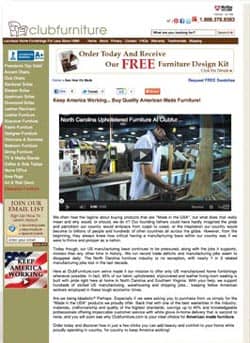 |
Online retailers generally do a good job of promoting Made in America. Clubfurniture.com says it is “your clear choice for American made furniture.” The website features an informative video and text that touts its domestically produced upholstery. There is no reason why brick and mortar retailers cannot tell their story in a substantial way online and through the use of other media. |
TIP #4: Optimize Your Website For Keywords & Phrases
“If you can manage to get Made in the USA or Made in Canada Furniture, and other important words and phrases into the descriptive text on your website without making it sound awful, that's great,” Andes says. “But if you want to track and rank high for specific words or phrases, it gets a little bit more sophisticated.
“In general, furniture retailers do have attractive sites, and they're doing a good job of getting their products up on the web. In terms of paying attention to how visible their website is when consumers search for keywords, and in the area of helping their stores stand out from the competition, however, they're not doing a very good job.
“And the reason that most aren’t paying close attention to website visibility, is that they don’t have anyone on staff who has the time or training to keep up with it, or they haven't outsourced it yet. It’s often hard for retailers to wrap their heads around what professionals are doing with keywords, title tags and alt tags. This is not necessarily work that needs to be done full-time, so it’s important to either find someone outside the organization who is skilled at this kind of work, or get a staffer some training and coaching.”
TIP #5: Create A Page or Section On Your Site
Armanda Turney, President of Armanda Designs, Inc., the web development company that created Furniture World’s www.furninfo.com website suggests that it is an excellent idea to create a separate web page or section that tells the story of why and how you buy domestically made goods. “Increase the effectiveness of your message by creating a page that tells your story,” she says. “Briefly discuss the choices you made and why it’s important for your business to offer American made or Canadian made furniture. Include photos, customer testimonials and related information on your suppliers, sustainable and quality features. But it’s not enough to just create a great looking page. Make sure that your page title, page section headings and meta tags include phrases that potential customers are most likely to type in to search engines such as, Made in the USA, Made in America, American furniture manufacturers, Made in Canada, etc. Also include supplier’s names in your meta tags. And finally, the visible text on your page should be written in a way that incorporates as many of these searchable words or phrases as is practical, without being too obvious.”
|
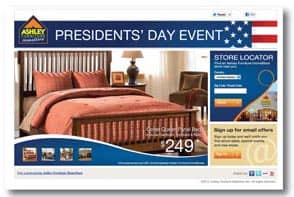
|
Retailers that carry furniture made in America should consider putting a logo or identifier on every page of their website, then take it one step further by adding alt and title tags to the images.
|
TIP #6: Use Pay Per Click Wisely
“If you're really ambitious,” concludes Andes, “you could run a pay per click campaign to tie into patriotic events on a national or local level right before holidays like the Fourth of July, President’s Day or Canada Day holidays. So when people are looking for information on local fireworks displays, other events, specific news items, or anything patriotic, you can quickly put up a pay per click campaign, and your ad will show up in a Google search next to the results.
“And it's a good idea to keep your eyes open for breaking news stories all year long. Recently a major network ran a series about furniture Made in America, and people were doing internet searches for additional information. You and your suppliers may not have been mentioned in the story, but you could still have done some pay per click advertising so that your ad appeared next to every search result for that story. Google ad words and other search engines have the same kinds of programs. You should be very careful using Google Ad Words though, because Google can run through a ton of your money very quickly. It’s important to hire a pay per click expert so that your ads don’t appear in the wrong places, causing too many clicks that are just empty clicks.
Some retail managers I know do their own pay per click ads. The successful ones spend a lot of time studying, and a lot of time tweaking their results. So, if you have a real passion, do it yourself. But if not, my suggestion is to bring in an expert.”
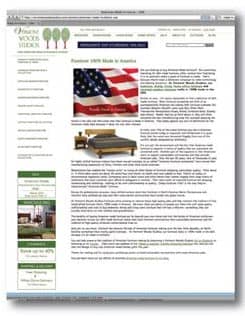 |
Vermont Wood Studios covers all the bases on its website (vermontwoodsstudios.com) which includes high quality video that tells customers about their business philosophy. It features a local craftsperson, speaks about environmental stewardship and product quality. The company has chosen not to link to the websites of their suppliers. A banner to Copeland Furniture provides complete information on the line including, “10 reasons to buy Copeland Furniture Here at Vermont Woods Studios.” The Made in USA logo appears on most every page, as does the SFC logo.
|
TIP #7: Attend To Patriotic Holiday Advertising
We’ve all seen ads that run before national holidays that promote huge discounts and attractive financing, accompanied by bold graphics. “I noticed some furniture store advertising this past President’s Day,” observes Made In USA Brand’s Marcie Gabor. “The ads were big on promotion, with lots of stars and stripes graphics. But it wasn’t possible to know from where these stores sourced their furniture. Holidays such as Presidents' Day and the Fourth of July are good times to think about doing something substantial, something big to promote Made in America and tell a real story.”
Diane Ray from Garden City Furniture is already working on this kind of promotion. “We are just beginning to kick off an advertising program emphasizing our Made in America effort,” she said. “In fact, our initial kick-off will be in July. Up until now, the news has been spread by word-of-mouth, floor displays and in-store signage. But we intend to begin to promote Made in America during a two-week Fourth of July Made in America sale. We are located in a resort community where the Fourth of July is enthusiastically celebrated. We sponsor fireworks in our local community, and are working on a flag give-away with purchase. Customers will receive a free American flag to display at their home if they so choose. The promotion will feature lots of signage at the front of the building playing up the Made in America direction. And of course we will promote with TV, radio, newspaper ads and through our website and Facebook page.”
As for big patriotic events to promote Made in Canada, Paul Dekker, owner of Conway Furniture, Listowel, Ontario told us, “I do some radio advertising focusing on some of our good Canadian suppliers. We also do a Canada Week event, and get as patriotic as Canadians get!”
TIP #8: Tell Your Story In Advertising & PR
If you don’t tell the story in your advertising and public relations efforts, you can’t do a good job of attracting customers that self-select for an interest in domestically produced products.
Larry Mullins has been telling Furniture World readers for years that creating selling messages in print is a lost art in the furniture industry. “Promotional flyers, ROP newspaper ads and direct mail all look alike and fail to tell a story,” he tells us. “Is ‘No Payments Until 2012’ really the only message we have for the consumer? Don’t we have anything to say about the things our fabulous products, dedicated service and unparalleled expertise can do for their home? They need to be complemented by a compelling message.” For stores that carry domestically sourced furniture, there is an opportunity to create a compelling story with emotional content. It can relate the history of your store, the history of your suppliers, consumer benefits and your motivations as a thoughtful merchant.
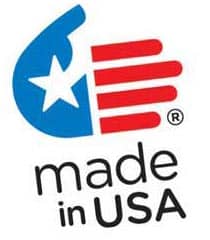 |
The Made in USA Brand certification mark, a non-mandatory brand enhancer and identifier of goods made or grown in the United States. |
A number of retailers are doing just that. “Wherever possible we promote Made In America products,” Gallery Furniture’s Mack McIngvale told Furniture World. “That’s because I think it makes people buy more from us, and appreciate who we are. When they see that we are working hard to provide jobs for Americans including some right here in Texas, I think that’s relevant, and it certainly increases our credibility. Plus it’s a big part of who we are and why we are in business. Our ads mention that we buy Made in America whenever possible to make the public aware that we sell Made in America upholstery and Made in America wood furniture.”
Chester Hine, from Amish Connection agrees that telling a story is key. “For retailers who are thinking about getting into American-made products,” he says, “it's just sales and marketing 101. You have to differentiate your product, and tell them what makes you different. In our case it’s the Amish craftsmanship, the solid wood and the conversion varnish finish. People are willing to pay for the quality if you can differentiate it, and talk about its longevity.”
Like Amish Connection, Debbie Crepeau’s company, Upperwoods Furniture Company, Edmonton, Alberta, is a domestic furniture specialist, though she carries only Canadian made products. “We are the ‘Passionate Purveyors of Canadian Made Furniture’, she tells Furniture World. We use this tag line on all of our mail pieces, ads and website, TV and even a little radio.”
The final word on promoting comes from A Royal Suite Home Furnishings’ Norb Moniz, Jr. “We recently went from carrying primarily mattresses and bedroom, to a full-line store, he explained. “Royal Suites has been around for over 30 years, and consumers have been requesting a wider selection of products from us. And due to the lack of independent retailers in our area, we decided to expand into a full-line store that actively promotes American-made products.”
Moniz, who is growing the percentage of domestically sourced products in his store, is the featured spokesperson in every one of his TV spots promoting the American-made theme. “We use mostly television and radio to promote the category,” he says, “Our television spots have been most effective with American-made products because people can see and hear our sincerity.”
He suggests that retailers work with suppliers to get listed on their websites and encourage them to tell their stories on a national level. Moniz tells of his recent experience following a national broadcast of an interview with Bruce Cochrane. “We are listed on The Lincolnton website,” he said. “When the program ran, we received about 30 phone calls. People said to us, ‘when you get the product in, we want it. Call us, and we are going to buy.’ It was as simple as that. No prices were mentioned and, it didn’t matter. It was unbelievable. Our phones rang off the hook for three days. Lincolnton is upper end for us, as is Furniture Traditions, another quality line we carry.”
A number of our interviewees mentioned that working with manufacturing partners is critically important. “For retailers to be able to do the best job they can, it has to start with the furniture manufacturer, Marcie Gabor advised. There is now a great opportunity for manufacturers to claim openly that they're making furniture here. It starts with a compelling story on the manufacturer’s website about where the product is made, its quality, and the craftsman who make it. The story continues with their label on their product, and with something visible like a hangtag that the consumer can easily see. I think that this has to be in place before retailers can convincingly convey the message to the public.” But it need not end there. Retailers can benefit by working to provide useful online information such as links to articles and videos, and by promoting the lines they carry in digital newsletters, article marketing, blogging and Facebook posts.
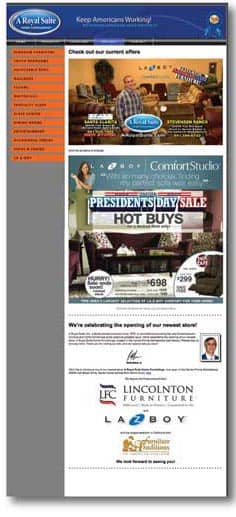 |
President’s Day Sale promotion on A Royal Suite’s website features Norb Moniz, Jr. saying, “I’m committed to putting Americans back to work. We feature American Made Furniture.” Moniz is also featured in their television spots. “Our television spots,” he says, “have been most effective with American-made products because people can see and hear our sincerity.”
|
TIP #8: Wayfinding In Your Store
Whether style and price is a customer’s primary focus, or if they are looking specifically for Made in USA or Made in Canada furniture, it is a good idea to let them know up front that you’ve made a commitment to the category.
Marcie Gabor whose certification mark is used by several furniture manufacturers, suggests that, “Wayfinding is important. Customers react on the spot to what they're seeing when they enter a store. So if the category isn’t easy to find, then you’ve lost an important opportunity. Point-of-purchase materials are really important and these are not limited to just hang tags. Floor decals, counter cards and shelf talkers, can be used to identify and tell about American-made products. And it can be done in a tasteful way. Sometimes retailers overdo it with huge flags and patriotic displays that may not be a good fit for their store. It is possible to get the point across in a more subtle, design friendly way, perhaps taking a hint from stores that feature organic products – a more lifestyle approach.”
Insideout Home Store’s Sue Toby, is thinking of taking a different approach for her Canadian-made furniture displays. “Signs on our display boards that say ‘Made in Canada’, and include a story about the products, where the wood came from, etc. I am getting some signs made that will say Canadian-made, but I want them to be special. I am thinking of using a beaver or a moose. Probably sounds weird, but I think they will turn out great!”
Upperwoods Furniture Company Owner Debbie Crepeau feels that she doesn’t need special signage to promote the category. “Specific techniques to highlight Made in Canada are not really needed in our store as ALL of our furniture is Canadian made,” she says.
TIP #9: Sales Associates Need To Tell Your Story
There are three main ways that retailers interviewed for this article tell their stories to customers. Some introduce domestic goods as a separate category with its own features and benefits. Others look at Made in USA or Made in Canada as a product feature. Specialists, like Debbie Crepeau’s Upperwoods Furniture Company goes further and treats these products as equivalent to her store’s brand.
“Our best salespeople introduce the topic of Made in Canada as customers enter our showroom,” continues Crepeau. “all our furniture is made in Canada and is of great quality. Solid wood, superior finishing process, controlled emissions and many of our manufacturers are focused on becoming green and using finishes that are formaldehyde free.”
New Mexico based retailer Norb Moniz, Jr., says that “the American-made story is part of our presentation. There's a quality aspect, a customer service dimension, and a delivery story. We don't bash imported goods and we don't bash our competitors. It's not our style. We feel customers out and make them aware if what they are looking at is American-made or not. Some people don't really care. The people that are strong American buyers, and we are seeing a huge amount of those right now, will tell you, ‘I only buy American, show me only American.’
“Maybe it's because we’ve been promoting it and getting behind it, but I've never seen anything like what’s happened in the last three months. The nice thing is that all of our salespeople on the floor, ownership, management and all the way down to our customer service department, all believe in it strongly. Everybody here is proud, more so every day, when they can sell American-made products. When I put a new group on the floor and it's made in America, they're excited.”
When asked about his salespeople, Gallery Furniture’s Mack McIngvale told Furniture World, “the good salespeople, and that’s about 60 per cent of them, bring it up. They say, ‘This upholstered sofa’s made in the United States.’ They tell customers what part of the country it’s made in, and they tell them a story about it. The good ones use it to their advantage. We have no problem telling the Made in America quality story, if it is indeed quality furniture. The stuff that is quality, we tell it loud and we tell it proud.
We tell them, for example, that the furniture we get from Mayo Manufacturing is made in Texas, is beautiful and that they don’t make furniture like that in China because it costs too much to ship it over here. We are proud to say that it’s bigger, better and it lasts longer. We also carry Simply Amish, a great Made in America line of upper-end bedroom and dining room furniture.”
“If you're a salesperson and you're talking about upholstery or case goods from Harden or Norwalk,” says Marcie Gabor, “the customer knows where it comes from. It doesn’t originate in an ambiguous location. Customers can go back and find out about its roots, it’s history, its quality story. It gives them a choice to buy a desk from Pottery Barn, of unknown origin, or they can buy from Vermont Wood Studios, Thomas Moser, or Stickley and create a legacy. Salespeople should always talk about what makes the product superior and sometimes even cost a little more. And, in addition to creating jobs at home, salespeople can present the benefits of buying local and buying green as well. Made in America is the next ‘green’ because there is such a hunger to buy green products, and now there is a similar craving for buying the red white and blue, made in USA products. A lot of that is because there is less of a carbon footprint for furniture products shipped locally or nationally versus globally.”
At Garden City Diane Ray told us that, “Right now we are looking at 20 to 25 per cent American-made goods on our floor. Our salespeople bring up that it's made in America, and do let customers know that we are making a strong push for made in America at this time. We have a whole collection with one factory, Vaughan Bassett. It is a big statement for us to have eight bedrooms from one vendor all made in America, on the floor. And It is great to see that people realize that we are offering such a great value. We also carry Bassett, Broyhill, Flexsteel, Smith Brothers, Yutsey and Winesburg. We will probably do business with additional Amish vendors and expanding the amount of Amish products on our floor.”
TIP #10: Don’t Forget Other Product Benefits
Only one of the retailers interviewed for this story, Paul Comrie at The Brick focused his comments on the back-end advantages he sees for buying domestic. “We are motivated to sell domestic goods for the inventory efficiencies and the benefit we derive from supporting local economies,” he noted. “Responding to a consumer’s desire to buy domestically made goods is our secondary reason. The primary reason is the benefits we receive on the supply chain side. Vendor reliability, quality of the product, low inventory carrying costs, and the ability to react quickly to promotional needs since we are such a promotional company.
“So far we have yet to see that you get a sales lift simply by calling that benefit out. The Brick has yet to see customers pay a premium for domestic goods, so the bigger benefit is not necessarily for the end consumer in our opinion. We believe the bigger benefit is for the retailer. And the more successful we are at selling domestic, the more streamlined our distribution becomes. The commitment we have had to make is on the margin component and recognizing that the price has to be equal to offshore in order to perform at retail. What we sell still comes down to the values we offer The Brick consumer. We recognize that we need to work on lower initial markup for domestic goods because the price needs to be equivalent to offshore goods with similar quality stories. Price still wins out on our floor so we have had to identify the value added benefits we get from domestic goods. If you don’t see that value and work on the same initial markup as offshore goods then most times you are putting the consumer in the position to pay a premium for domestic goods. Offshore will win out every time on our floor in that scenario.”
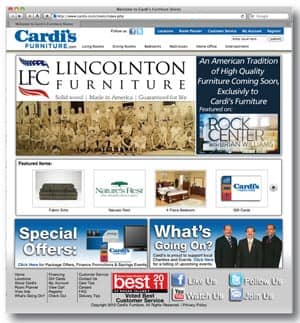 |
Cardi’s Furniture’s website (left) featured a large banner for Lincolnton Furniture with links to an interview featuring that manufacturer on NBC’s Rock Center.
|
TIP #11: Ask Suppliers For Support
Norb Moniz, Jr. explains that, “The problem we have as retailers, of course, is the lack of American-made furniture products. I've seen a substantial increase in that, and if you really sit down and do some research, and really look for vendors, you can find them. And those American-made companies are hungry and willing to do what they need to do. More so than ever before. They are glad to participate in flooring of the goods, and customer service. There's so much more available now from American-made manufacturers.”
Conclusion
In the past few months the industry has seen a modest increase in the number of domestic furniture manufacturing jobs. And despite consolidation in the Canadian furniture market, strong domestic producers persist. Companies like Stickley, Harden, Vaughan Bassett, Copeland Furniture, AA Laun, Omnia, Braxton Culler, Décor-Rest, Ashley, Bassett, Bermex, Dutailier, Furniture Traditions, Hickory Chair, Elran, Country View, Flexsteel and scores of others design and manufacture a wide range of domestic products. The result is that domestically made furniture at all price points, and with mainstream styling, is easy to find.
Clearly Norb Moniz, Jr., of A Royal Suite Home Furnishings is excited. “I believe,” he said, “that when I come back from High Point next year, American-made could be 80 per cent of our store. It's a huge trend right now. Furniture retailers, manufacturers and consumers are going to be the ones to put Americans back to work.”
Garden City Furniture was founded in 1947 by Diane Ray’s father. She told Furniture World that like many in our business she “grew up during the time when American furniture brands were really strong. And I can say God bless America, I'm so glad to see the industry come back here. We are a small independent store of 40,000 square feet and it's been a learning curve to have to deal with the import products over the years. We survived, we dealt with it, and changed our methods of doing business.
“Today our consumers are saying, ‘I want to know where this was made, what kind of woods it’s made from, and I want to feel good about purchasing this piece of furniture. They see that America is ready for a new direction. I know our consumers are happy to see these products in our store. Their eyes just light up when we say, ‘this piece is made right here in the United States, in Virginia, shipped to us, just the way it used to be.’ And it feels good when I call up a factory and say, ‘I need one night stand,’ and hear the reply, ‘I'll have it to you tomorrow, Ms. Ray.’”
Bruce Cochrane gives us our final words on this subject. “I think what I'm seeing mainly is a lot of retailers realize how important American-made furniture is,” he told Furniture World, “because they are having so many customers come into their stores and ask about it, now more so than ever before. That's something that I hear from retailers as I travel all over the country. I also see that many of them don't have any American-made products at all, and even if they do, they don't have enough to really make enough of a statement. So number one, retailers need to have it on the floor if they want to promote it. Number two, if they have it, they need to promote it, mention it in their ads, and say, ‘come see our made in America collections.’”
See the complete Made-in-America Section at...
http://www.pageturnpro.com/Furniture-World-magazine/37687-furniture-World-Magazine-MarchApril-2012/index.html#16
Furniture World is the oldest, continuously published trade publication in the United States. It is published for the benefit of furniture retail executives. Print circulation of 20,000 is directed primarily to furniture retailers in the US and Canada. In 1970, the magazine established and endowed the Bernice Bienenstock Furniture Library (www.furniturelibrary.com) in High Point, NC, now a public foundation containing more than 5,000 books on furniture and design dating from 1620. For more information contact editor@furninfo.com.